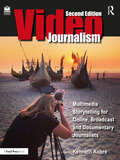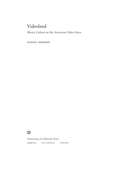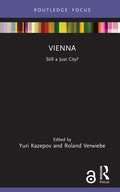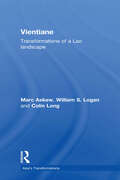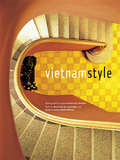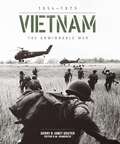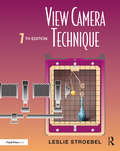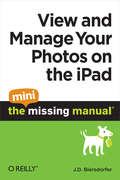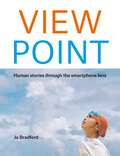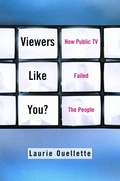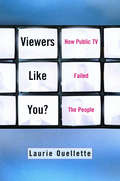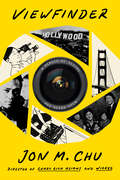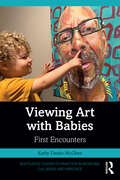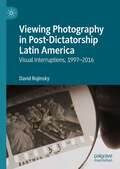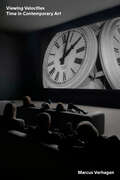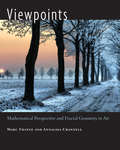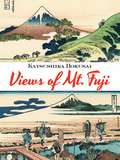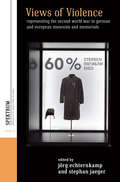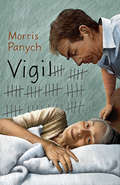- Table View
- List View
Videojournalism: Multimedia Storytelling for Online, Broadcast and Documentary Journalists
by Kenneth KobreVideojournalism: Multimedia Storytelling for Online, Broadcast and Documentary Journalists is an essential guide for solo video storytellers—from "backpack" videojournalists to short-form documentary makers to do-it-all broadcast reporters.Based on interviews with award-winning professionals sharing their unique experiences and knowledge, Videojournalism covers topics such as crafting and editing eye-catching short stories, recording high-quality sound, and understanding the laws and ethics of filming in public and private places. Other topics include:• understanding the difference between a story and a report• finding a theme and telling a story in a compact time frame• learning to use different cameras and lenses—from smart phones to mirrorless and digital cinema cameras• using light, both natural and artificial • understanding color and exposureThe second edition of this best-selling text has been completely revised and updated. Heavily illustrated with more than 550 photographs, the book also includes more than 200 links to outstanding examples of short-form video stories. Anatomy of a News Story, a short documentary made for the book, follows a day in the life of a solo TV videojournalist on an assignment (with a surprise ending), and helps readers translate theory to practice.This book is for anyone learning how to master the art and craft of telling real, short-form stories with words, sound, and pictures for the Web or television.A supporting companion website links to documentaries and videos, and includes additional recommendations from the field’s most prominent educators.
Videoland
by Daniel HerbertVideoland offers a comprehensive view of the "tangible phase" of consumer video, when Americans largely accessed movies as material commodities at video rental stores. Video stores served as a vital locus of movie culture from the early 1980s until the early 2000s, changing the way Americans socialized around movies and collectively made movies meaningful. When films became tangible as magnetic tapes and plastic discs, movie culture flowed out from the theater and the living room, entered the public retail space, and became conflated with shopping and salesmanship. In this process, video stores served as a crucial embodiment of movie culture's historical move toward increased flexibility, adaptability, and customization.In addition to charting the historical rise and fall of the rental industry, Herbert explores the architectural design of video stores, the social dynamics of retail encounters, the video distribution industry, the proliferation of video recommendation guides, and the often surprising persistence of the video store as an adaptable social space of consumer culture. Drawing on ethnographic fieldwork, cultural geography, and archival research, Videoland provides a wide-ranging exploration of the pivotal role video stores played in the history of motion pictures, and is a must-read for students and scholars of media history.
Vienna: Still a Just City? (Built Environment City Studies)
by Yuri KazepovThis book explores and debates the urban transformations that have taken place in Vienna over the past 30 years and their consequences in policy fields such as labour and housing, political and social participation and the environment. Historically, European cities have been characterised by a strong association between social cohesion, quality of life, economic ambition and a robust State. Vienna is an excellent example for that. In more recent years, however, cities were pressured to change policy principles and mechanisms in the context of demographic shifts, post-industrial transformations and welfare recalibration which have led to worsened social conditions in many cities. Each chapter in this volume discusses Vienna’s responses to these pressures in key policy arenas, looking at outcomes from the context-specific local arrangements. Against a theoretical framework debating the European city as a model of inclusion and social justice, authors explore the local capacity to innovate urban policies and to address new social risks, while paying attention to potential trade-offs. The book questions and assesses the city’s resilience using time series and an institutional analysis of four key dimensions that characterise the European city model within the context of post-industrial transition: redistribution, recognition, representation and sustainability. It offers a multiscalar perspective of urban governance through labour, housing, participatory and environmental policies, bringing together different levels and public policy types. Vienna: Still a Just City? is aimed at academics, researchers and policy-makers in urban studies, including urban sociology, ecology, geography and welfare.
Vientiane: Transformations of a Lao landscape (Routledge Studies in Asia's Transformations)
by William Logan Colin Long Marc AskewProviding insights into this neglected Southeast Asian city, this interesting book interprets Vientiane’s landscape - physical as well as imagined - as a reflection of key aspects of Lao geo-political history, the nature of Lao urbanism, and its critical relation to constructions of Lao identity in the contemporary period. It is argued that the patterns of change seen through Vientiane’s past embody the key political and economic processes and transformations impacting on the people of Laos. The Lao urban past has rarely been an object of attention by scholars. Laos, in fact, is continually portrayed as a rural backwater, marginal to the dynamic trends affecting most of the Southeast Asian mainland. In contrast to these persistent and static portrayals of Laos as a tiny landlocked backwater, with no significant urban present or past, the authors aim to document, explain and evaluate the significance of the Lao urban landscape. Focusing on the theme of Vientiane’s ‘marginality’ in its various forms, the book interprets this apparent marginality as an historically-produced phenomenon resulting from geo-politics dating from the pre-colonial period and extending into the post-colonial period. Drawing on a wide range of research materials, Vientiane is the first work of its kind on this ignored city.
Vietnam Style
by Luca Invernizzi Tettoni Bertrand De Hartingh Anna Craven-Smith-MilnesVietnam has long captured the imagination of travelers, both real and armchair. It is an appealing country, filled with natural beauty, tranquil village life and fascinating cities. Vietnam also has an inimitable architectural and interior design style, the product of its rich cultural heritage and the various influences of Chinese, French and other Western colonialism.Vietnam Style is an exploration of the balancing act between traditional vernacular design and architecture and the outside influences of colonialism. The unusual and striking new design styles created by melding these elements are a true cultural kaleidoscope of Vietnam today. Chinese-style shophouses, temples with Indian influences, Thai-style palaces, French Colonial civic and domestic buildings, and the variety of tribal and native wooden houses present in Vietnam Style offer an intimate look into the vibrant, yet virtually unknown world of modern Vietnamese architecture and design.
Vietnam: The Unwinnable War
by Gerry and SouterVietnam: The Unwinnable War is a dramatic guide to the suffering, sacrifice and heroism of one of the most significant and debated periods in twentieth-century history. Expertly retold with searing imagery and accounts of the events that unfolded, this definitive visual history memorializes this controversial and bloody conflict. Also included are 20 pieces of memorabilia reproduced on the page, taken from US archives and personal collections to give an authentic and moving telling of events, from personal letters from US soldiers, US Airborne calling cards, extracts from US Army phrasebooks, and even letters sent between the Vietnamese and American governments during the fighting.See the war through the eyes of those that experienced it first-hand and gain a deeper understanding of this historical moment and its human and political cost.
Vietnam: The Unwinnable War
by Gerry and SouterVietnam: The Unwinnable War is a dramatic guide to the suffering, sacrifice and heroism of one of the most significant and debated periods in twentieth-century history. Expertly retold with searing imagery and accounts of the events that unfolded, this definitive visual history memorializes this controversial and bloody conflict. Also included are 20 pieces of memorabilia reproduced on the page, taken from US archives and personal collections to give an authentic and moving telling of events, from personal letters from US soldiers, US Airborne calling cards, extracts from US Army phrasebooks, and even letters sent between the Vietnamese and American governments during the fighting.See the war through the eyes of those that experienced it first-hand and gain a deeper understanding of this historical moment and its human and political cost.
Vietnamese in Orange County
by Linda Trinh Vo Thuy Vo Dang Tram LeVietnamese Americans have transformed the social, cultural, economic, and political life of Orange County, California. Previously, there were Vietnamese international students, international or war brides, or military personnel living in the United States, but the majority arrived as refugees and immigrants after the end of the Vietnam War in 1975. Although they are lumped together as "refugees," Vietnamese Americans are diverse in terms of their class, ethnic, regional, religious, linguistic, and ideological backgrounds. Their migration path varied, and they often struggled with resettling in a new homeland and rebuilding their lives. They are dispersed throughout the country, but many are concentrated in central Orange County, where three cities--Westminster, Garden Grove, and Santa Ana--have "Welcome to Little Saigon" signs. They constitute the largest population of Vietnamese outside of Vietnam and have created flourishing residential neighborhoods and bustling commercial centers and contribute to the political and cultural life of the region. This book captures snapshots of Vietnamese life in Orange County over the span of 40 years and shows a dynamic, vibrant community that is revitalizing the region.
View Camera Technique
by Leslie StroebelNow in its seventh edition, View Camera Technique is a unique, comprehensive book that presents clearly and precisely the features, operations and applications of view cameras. It details camera movements, image formation, exposure control, and information concerning lenses and accessories. Diagrams, comparison charts, and more than 500 photographs and illustrations by distinguished professional photographers provide the reader with the tools necessary to analyze a picture situation, set up and manipulate the camera, and portray the subject to meet the expectations of the professional photographer. This text has been completely revised and updated to include over 100 brand-name view cameras, and offers comparison tables to assist readers in choosing cameras, lenses, and view-camera digital backs. This latest edition offers expanded coverage of the newest technology, including electronic features that simplify the use of view cameras for conventional photography and digital view cameras that eliminate the need for film and make it possible to modify the digital images with image-processing computer software programs
View and Manage Your Photos on the iPad: The Mini Missing Manual
by J. D. BiersdorferOne of the iPad's big pluses is its beautiful, high-resolution display. That makes it a perfect way to stroll down memory lane-from the comfort of your armchair. View and Manage Your Photos on the iPad: The Mini Missing Manual shows you how to import, organize, and enjoy your photos using clear, jargon-free explanations and step-by-step instructions.You'll learn to create slideshows complete with your own soundtrack and transitions, connect your tablet to a big-screen TV so you can gather the family around, turn your slab into a digital picture frame (a great idea when you recharge your 'Pad), use a treasured photo as your wallpaper, and share your images with friends by attaching one--or many-pics to a message.You'll also learn how to import your images into the iPad using iTunes' easy syncing feature, how to pull pictures off of email messages and into your tablet's photo album, and how to import pictures directly from your camera.In short, this Mini Missing Manual tells you everything you need to know to view and manage your photos on your iPad.
ViewPoint: Human stories through the smartphone lens
by Jo BradfordInternational in scope and full of beautiful and impactful imagery that highlights the immediacy of the genre, View/Point is a book of human experience stories as told through the medium of phone photography. Featuring more than 50 contributors from every corner of the globe, interviewed by the author about their lives and their photographic art, this book offers a definitive take on both the power of the still image to tell a story and the joy of personal expression that phone photography offers.
ViewPoint: Human stories through the smartphone lens
by Jo BradfordInternational in scope and full of beautiful and impactful imagery that highlights the immediacy of the genre, View/Point is a book of human experience stories as told through the medium of phone photography. Featuring more than 50 contributors from every corner of the globe, interviewed by the author about their lives and their photographic art, this book offers a definitive take on both the power of the still image to tell a story and the joy of personal expression that phone photography offers.
Viewers Like You: How Public TV Failed the People
by Laurie OuelletteHow "public" is public television if only a small percentage of the American people tune in on a regular basis? When public television addresses "viewers like you," just who are you? Despite the current of frustration with commercial television that runs through American life, most TV viewers bypass the redemptive "oasis of the wasteland" represented by PBS and turn to the sitcoms, soap operas, music videos, game shows, weekly dramas, and popular news programs produced by the culture industries. Viewers Like You? traces the history of public broadcasting in the United States, questions its priorities, and argues that public TV's tendency to reject popular culture has undermined its capacity to serve the people it claims to represent. Drawing from archival research and cultural theory, the book shows that public television's perception of what the public needs is constrained by unquestioned cultural assumptions rooted in the politics of class, gender, and race.
Viewers Like You: How Public TV Failed the People
by Laurie OulletteHow "public" is public television if only a small percentage of the American people tune in on a regular basis? When public television addresses "viewers like you," just who are you? Despite the current of frustration with commercial television that runs through American life, most TV viewers bypass the redemptive "oasis of the wasteland" represented by PBS and turn to the sitcoms, soap operas, music videos, game shows, weekly dramas, and popular news programs produced by the culture industries. Viewers Like You? traces the history of public broadcasting in the United States, questions its priorities, and argues that public TV's tendency to reject popular culture has undermined its capacity to serve the people it claims to represent. Drawing from archival research and cultural theory, the book shows that public television's perception of what the public needs is constrained by unquestioned cultural assumptions rooted in the politics of class, gender, and race.
Viewfinder: A Memoir of Seeing and Being Seen
by Jeremy McCarter Jon M. ChuFrom visionary director Jon M. Chu comes a powerful, inspiring memoir of belonging, creativity, and learning to see who you really are.&“A must-read for aspiring artists and dreamers of all kinds.&”—Ava DuVernayLong before he directed Wicked, In The Heights, or the groundbreaking film Crazy Rich Asians, Jon M. Chu was a movie-obsessed first-generation Chinese American, helping at his parents&’ Chinese restaurant in Silicon Valley and forever facing the cultural identity crisis endemic to children of immigrants. Growing up on the cutting edge of twenty-first-century technology gave Chu the tools he needed to make his mark at USC film school, and to be discovered by Steven Spielberg, but he soon found himself struggling to understand who he was. In this book, for the first time, Chu turns the lens on his own life and work, telling the universal story of questioning what it means when your dreams collide with your circumstances, and showing how it&’s possible to succeed even when the world changes beyond all recognition. With striking candor and unrivaled insights, Chu offers a firsthand account of the collision of Silicon Valley and Hollywood—what it&’s been like to watch his old world shatter and reshape his new one. Ultimately, Viewfinder is about reckoning with your own story, becoming your most creative self, and finding a path all your own.
Viewing America
by Christopher BigsbySomething has happened in the world of television drama. For the last decade and a half America has assumed a dominant position. Novelists, screenwriters and journalists, who would once have had no interest in writing for television, indeed who often despised it, suddenly realised that it was where America could have a dialogue with itself. The new television drama was where writers could engage with the social and political realities of the time, interrogating the myths and values of a society moving into a new century. Familiar genres have been reinvented, from crime fiction to science fiction. This is a book as much about a changing America as about the television series which have addressed it, from The Sopranos and The Wire to The West Wing, Mad Men and Treme, in what has emerged as the second golden age of American television drama.
Viewing Art with Babies: First Encounters (Routledge Guides to Practice in Museums, Galleries and Heritage)
by Kathy Danko-McGheeViewing Art with Babies demonstrates how to facilitate quality art viewing experiences with babies from as young as 2 months old. Such experiences can help to nurture early literacy and receptive language skills, sensory stimulation, and early brain development. Based on the author’s research with babies in New Zealand, Australia, Romania, England, and the U.S., the book provides the reader with information about early brain, vision, sensory and language development, and the aesthetic preferences of babies. Danko-McGhee provides details about the type of art that babies like, how to display art in the learning environment, and how to interact with a baby when viewing art. Case studies of international museums, national museums, and community agencies that have had success with engaging babies in art viewing experiences have been included in the book as a way of demonstrating how theory and research can be successfully put into practice. Viewing Art with Babies details practical ways through which museum practitioners, early childhood and community educators, and parents can provide artviewing experiences in the museum, early childhood classroom or even their own home. It will be of interest to practitioners and parents around the world, and those engaged in the study of museum education.
Viewing Inscriptions in the Late Antique and Medieval World
by Antony EastmondInscriptions convey meaning not just by their contents but also by other means, such as choice of script, location, scale, spatial organisation, letterform, legibility and clarity. The essays in this book consider these visual qualities of inscriptions, ranging across the Mediterranean and the Near East from Spain to Iran and beyond, including Norman Sicily, Islamic North Africa, Byzantium, medieval Italy, Georgia and Armenia. While most essays focus on Late Antiquity and the Middle Ages, they also look back at Achaemenid Iran and forward to Mughal India. Topics discussed include real and pseudo-writing, multilingual inscriptions, graffiti, writing disguised as images and images disguised as words. From public texts set up on mountainsides or on church and madrasa walls to intimate craftsmen's signatures, barely visible on the undersides of precious objects, the inscriptions discussed in this volume reveal their meanings as textual and visual devices.
Viewing Photography in Post-Dictatorship Latin America: Visual Interruptions, 1997-2016
by David RojinskyThis book examines the archival aesthetic of mourning and memory developed by Latin American artists and photographers between 1997-2016. Particular attention is paid to how photographs of the assassinated or disappeared political dissident of the 1970s and 1980s, as found in family albums and in official archives, were not only re-imagined as conduits for private mourning, but also became allegories of social trauma and the struggle against socio-political amnesia. Memorials, art installations, photo-essays, street projections, and documentary films are all considered as media for the reframing of these archival images from the era of the Cold War dictatorships in Argentina, Chile, Guatemala, and Uruguay. While the turn of the millennium was supposedly marked by “the end of history” and, with the advent of digital technologies, by “the end of photography,” these works served to interrupt and hence, belie the dominant narrative on both counts. Indeed, the book's overarching contention is that the viewer’s affective identification with distant suffering when engaging these artworks is equally interrupted: instead, the viewer is invited to apprehend memorial images as emblems of national and international histories of ideological struggle.
Viewing Velocities: Time in Contemporary Art
by Marcus VerhagenContemporary art and the culture of speedHow have artists responded to our market-driven, tech-enabled culture of speed? Viewing Velocities explores a contemporary art scene caught in the gears of 24/7 capitalism. It looks at artists who embrace the high-octane experience economy and others who are closer to the slow movement. Some of the most compelling artworks addressing the cadences of contemporary work and leisure play on distinct, even contradictory conceptions of time. From Danh Vo's relics to Moyra Davey's photographs of dust-covered belongings, from Roman Ondak's queuing performers and Susan Hiller's outdoor sleepers to Maria Eichhorn's art strike and Ruth Ewan's giant reconstruction of the French revolutionary calendar, artists have drawn out aspects of the present temporal order that are familiar to the point of near-invisibility, while outlining other, more liberating ways of conceiving, organising and experiencing time.Marcus Verhagen builds on the work of theorists Jonathan Crary, Hartmut Rosa and Jacques Rancière to trace lines of insurgent art that recast struggles over time and history in novel and revealing terms.
Viewpoints: Mathematical Perspective and Fractal Geometry in Art
by Annalisa Crannell Marc FrantzAn undergraduate textbook devoted exclusively to relationships between mathematics and art, Viewpoints is ideally suited for math-for-liberal-arts courses and mathematics courses for fine arts majors. The textbook contains a wide variety of classroom-tested activities and problems, a series of essays by contemporary artists written especially for the book, and a plethora of pedagogical and learning opportunities for instructors and students. Viewpoints focuses on two mathematical areas: perspective related to drawing man-made forms and fractal geometry related to drawing natural forms. Investigating facets of the three-dimensional world in order to understand mathematical concepts behind the art, the textbook explores art topics including comic, anamorphic, and classical art, as well as photography, while presenting such mathematical ideas as proportion, ratio, self-similarity, exponents, and logarithms. Straightforward problems and rewarding solutions empower students to make accurate, sophisticated drawings. Personal essays and short biographies by contemporary artists are interspersed between chapters and are accompanied by images of their work. These fine artists--who include mathematicians and scientists--examine how mathematics influences their art. Accessible to students of all levels, Viewpoints encourages experimentation and collaboration, and captures the essence of artistic and mathematical creation and discovery. Classroom-tested activities and problem solving Accessible problems that move beyond regular art school curriculum Multiple solutions of varying difficulty and applicability Appropriate for students of all mathematics and art levels Original and exclusive essays by contemporary artists Forthcoming: Instructor's manual (available only to teachers)
Views of Mt. Fuji: One Hundred Views Of Mt. Fuji
by Katsushika HokusaiKatsushika Hokusai was among the foremost ukiyo-e artists of his generation, and his Thirty-six Views of Mt. Fuji ranks among the best-known series of Japanese woodblock prints. This edition presents a full-color reprint of that enduring masterpiece, plus the artist's later black-and-white series, One Hundred Views of Mt. Fuji. A must for all lovers of Japanese art.
Views of Violence: Representing the Second World War in German and European Museums and Memorials (Spektrum: Publications of the German Studies Association #19)
by Jörg Echternkamp Stephan JaegerTwenty-first-century views of historical violence have been immeasurably influenced by cultural representations of the Second World War. Within Europe, one of the key sites for such representation has been the vast array of museums and memorials that reflect contemporary ideas of war, the roles of soldiers and civilians, and the self-perception of those who remember. This volume takes a historical perspective on museums covering the Second World War and explores how these institutions came to define political contexts and cultures of public memory in Germany, across Europe, and throughout the world.
Vigil
by Morris PanychA man returns after thirty years to sit with a relative on her deathbed. Kemp's problem is: she's not dying fast enough. Through Kemp's own errors and inattentiveness, the visit that he thinks will take a day or two stretches into a year. A play of mistaken identity, twisted circumstance, and surprising turns, this is one Vigil worth keeping.
Viking Art (World of Art)
by James Graham-CampbellThe Viking Age in Europe lasted from the time of the first major Viking expeditions in 800 CE to the widespread adoption of Christianity in Scandinavia some 300 years later. During that time, Viking art and culture spread across continental Europe and into the world beyond. Written by a leading authority on the subject, this book introduces readers to the intricate objects and beautiful art styles that developed during the Viking Age.
